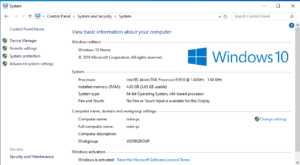
- #Novabench scores explained how to#
- #Novabench scores explained mac os x#
- #Novabench scores explained software#
- #Novabench scores explained windows#
#Novabench scores explained how to#
The user interface is horrible, so complicated that you’re never sure where any particular file is and how to get to it. I used File History (built into Windows) for a while, but started to notice that files were being skipped, with no explanation.
#Novabench scores explained windows#
I liked Time Machine on my Mac, but I switched to Windows about six months ago. Original photo files are archived to Amazon S3, as described here.

But the incremental updates generally complete in less than a day. I have about 800GB there (including 50,000+ photos), and it took a month or two to get it all uploaded. So, you need to combine several backup methods.)Įverything is backed up with CrashPlan, which is cheap and has an excellent client application. More protection means less convenience, and less convenience means that you won’t do the backups often enough. (Quick summary: You need to protect against user error, computer failure, surge, disappearance, office destruction, and regional disaster.
#Novabench scores explained software#
I wrote an article in 2008 called “ How To Back Up Your Personal Computer” that gave the best advice ever about what threats you’re trying to protect yourself from and how to handle them, but, of course, the specific hardware and software I use has changed a lot over the past 8 years. This entry was posted in Computer Stuff, Photography on 17-September-2016 by admin. But, like Adobe, their apps don’t run on Linux. If a Lightroom competitor comes forth, it will most likely come from Affinity, whose Photo and Designer apps probably are giving Adobe sleepless nights. If the Linux, MySQL, and Apache developers had that attitude, they would have gotten nowhere.
#Novabench scores explained mac os x#
Another reviewer was bothered by digiKam’s white screen, figured out how to make it gray, and then showed screen shots of digiKam and Lightroom side-by-side and figuratively patted himself on the back.ĭigiKam comes from the Linux world, although there are ports to Mac OS X and Windows, and the Linux people usually grade on the curve. One guy made a comment that he didn’t use Lightroom, but his brother did, and, from what he could tell, the two apps were pretty much the same. A combination of group-think, denial, ignorance, and boosterism. In the course of investigating digiKam, I came upon several very positive online reviews and user comments, and found most of them pretty sad. Maybe they think that since they’re changing actual image files, they can stand for themselves when you need a JPEG externally. I couldn’t believe the app couldn’t do this, so I spent a couple of hours working on it, but I’m convinced. Lots of features, but it won’t work for me because (1) the raw editing is incredibly clunky, and isn’t parameterized like Lightroom (no going back to tweak an adjustment), and (2) no way to export JPEGs to a folder, something I do all the time when I create magazines and books, prepare a slideshow, upload to, and lots of other things. Maybe whoever works on the Windows port can get a better monitor for Christmas. Didn’t get far, because the screen font was too small to read on my monitor, with no way to make it any bigger other than to change the resolution of the monitor, which is out of the question. ($10/month for Lightroom + Photoshop is an incredible bargain.)įirst, I tried Lightzone. Not because I’m thinking of switching, but just to stay informed. Two Lightroom non-alternativesįrom time-to-time I take a look at Lightroom alternatives. This entry was posted in Computer Stuff on 5-October-2016 by admin. But all of my important apps (notably Lightroom and Photoshop) are on both.Īnd Windows hardware is substantially cheaper, no matter what Apple and Mac fanboys say. There are also, of course, lots of Windows apps that aren’t on MacOS. In fact, there’s no ProofSheet or ExifChanger, two of my own apps. For example, there’s no Coda for Windows. There is still a difference between what apps are available. Now, as far as I’m concerned, there is no non-superficial difference between Windows and MacOS as OSes. This is somewhat more convenient than what MacOS has, because its shell has BSD commands, whereas the Linux (GNU, really) commands are more widely known. (As I understand it–I only spent 2 minutes looking into the technicalities.) Linux itself isn’t there, but the kernel API is. It’s the real thing, a joint project between Microsoft and Canonical. Well, I just discovered that Windows now has a Subsystem for Linux, which runs a genuine Ubuntu shell.

I used that a lot, especially when running scripts. The feature I missed was being able to open up a UNIX shell.

Some apps, such as Lightroom, Photoshop, and a few others, were identical. Many details were different, of course, but both systems had the same functionality (almost). When I switched to Windows as my main machine last January, I found that, except for one thing, it worked more-or-less the same as MacOS.


 0 kommentar(er)
0 kommentar(er)
